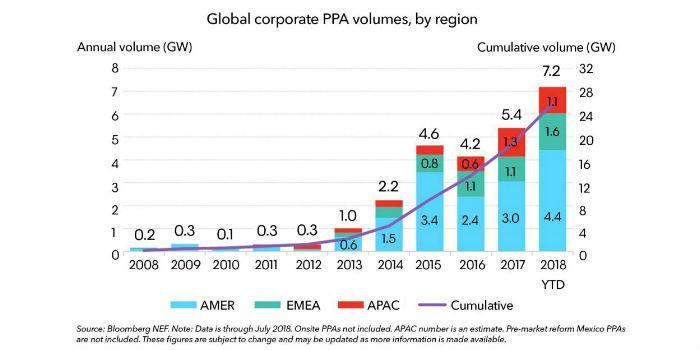 International. A new report from Bloomberg NEF shows that corporations already bought 7.2GW of clean energy globally from 2018 to July, breaking the previous record of 5.4GW for all of 2017. Companies have now signed long-term contracts to purchase solar and wind power in 28 markets, and the number of industries involved in purchasing clean energy continues to grow.
International. A new report from Bloomberg NEF shows that corporations already bought 7.2GW of clean energy globally from 2018 to July, breaking the previous record of 5.4GW for all of 2017. Companies have now signed long-term contracts to purchase solar and wind power in 28 markets, and the number of industries involved in purchasing clean energy continues to grow.
What is driving this growth?
Many corporate sustainability plans promote actions that reduce or offset emissions internally and incentivize the construction of new clean energy projects, two complementary goals realized through corporate power purchase agreements (PPAs). But activity would not approach current levels if there was no opportunity for long-term savings. The costs of PV modules have decreased by 84% globally since 2010, while the costs of wind turbines have fallen by 32% in the same period, according to Bloomberg NEF in its recently published New Energy Outlook.
Coupled with the efficiency improvements that have driven operating hours at renewable plants, these cost reductions have made renewable resources cost-competitive with wholesale energy prices and more traditional electricity sources. As a result, we are seeing corporations commit to long-term, protecting themselves against volatile prices in the wholesale market. This is known as the virtual PPA model and remains the most common corporate acquisition mechanism.
Where is the growth happening?
The United States and Nordic countries accounted for just under 80% of corporate purchasing activity in 2018. In the United States, companies have become more comfortable with the virtual PPA model, which acts as the contractor on several projects, but smaller companies are also increasingly combining electricity demand together to access economies of scale achieved through large projects. of solar and wind energy, known as aggregation. In the Nordic countries, a market with a predominance of companies with high electricity demand and sustainability goals, companies are attracted by the strong wind resources and nordpool's energy market, which allows buying, delivering and selling electricity between Sweden and Norway. Australia and Mexico remain two nascent markets where activity is starting to pick up, due to expensive wholesale energy prices and strong renewable resources.
Who is leading the charge?
Tech companies are the biggest buyers of clean energy, acquiring 1.8GW so far in 2018. Facebook has been the biggest corporate buyer this year, working with regulated utilities in the U.S. and signing a wind PPA in Norway to bring its total clean energy purchases to 1.1GW in 2018. Materials companies are very close, with 1.4GW purchased in 2018. This activity comes largely from the back of aluminum makers Norsk Hydro and Alcoa in the Nordic countries, which use low-carbon credentials to sell aluminum at a premium in some markets.
What can we expect from moving forward?
Bloomberg NEF forecasts that the current 140 signatories to the RE100 (a pledge to offset 100% of electricity demand with renewables) will need to purchase an additional 197TWh of clean energy by 2030 to reach their targets. If this shortfall were resolved with long-term contracts for new solar and wind power projects, it would result in an additional 100 GW of construction. In this context, this is slightly larger than the entire California power grid today.
Meanwhile, the number of companies registered in the RE100 continues to grow. As more multinationals set renewable energy targets, we expect companies to have an increasing impact on the design of the energy market around the world, opening up new avenues for companies to buy clean energy.
Source: Bloomberg NEF.














